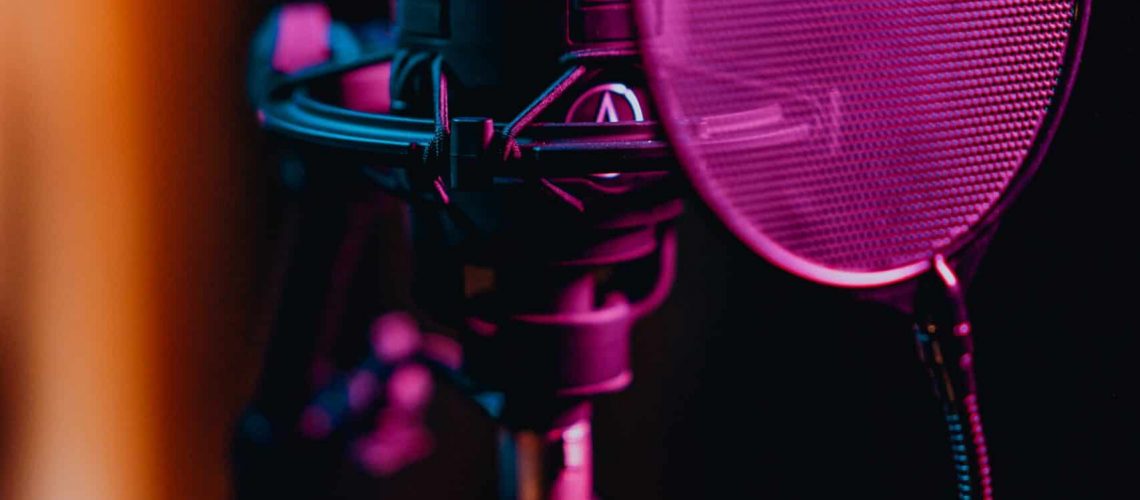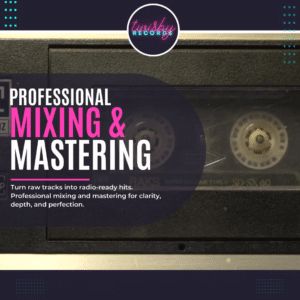Hey there!
We’re gonna talk about one of my favorite topics, GEAR! I’m serious, I’ve got a problem. I love gear, and acquiring it. Finding out ways to shoehorn the 5 millionth mic, mic pre, outboard compressor, etc. into my workflow.
I’ve been fortunate enough to have a lot of experience with a wide variety of gear, at a wide variety of price points. So, I’m putting that knowledge to (virtual) paper to help slim down the seemingly endless options of audio interfaces, mics, headphones, etc. into a few choices that fit a few different budget sizes that will help to level up your recording game.
THE BEDROCK, THE FOUNDATION, THE CORNERSTONE, THE MICROPHONE!
Lewitt 240 Pro – $169

So, Lewitt was a brand that’s eluded me only until just a couple years ago. I started to notice them popping up in the hands of podcasters on YouTube and after some good advertising on Facebook they roped me into giving them a shot.
.One of the main benefits of the Lewitt 240 Pro is its versatility. It features a cardioid polar pattern, which means it is sensitive to sounds from the front of the microphone while rejecting sounds from the sides and rear. This makes it perfect for recording vocals, acoustic guitars, and other acoustic instruments. This mic also features a switchable low-cut filter, and it has a switchable -10dB pad, which enables it to handle high sound pressure levels, making it suitable for recording loud instruments like drums or electric guitar amps.
The Lewitt 240 Pro’s sound quality is outstanding, with a smooth and natural frequency response that features a high end bump. The microphone’s high sensitivity and low self-noise ensure that your recordings are clear, detailed, and free from unwanted noise. This mic is a monster to beat at this price point, and personally I’ve grown to prefer it to mics in similar price points.
Leweitt 440 Pure – $289

The bigger brother of the 240 pro. So, what does an extra $120 get you? On the accessories side you get a pop filter, along with all the other accessories included in the package that comes with the 240 Pro. The Lewitt 440 Pure is a high-quality microphone that can capture the nuances of your performance. Compared to the Lewitt 240 Pro, the 440 Pure offers a few key differences that make it an excellent choice for recording vocals, acoustic instruments, and even electric guitar amps.
One feature of the 440 Pure is its ability to handle high sound pressure levels, making it suitable for recording loud instruments like drums and electric guitar amps. The microphone also features a low-cut filter and a -10dB pad, similar to the 240 Pro, which allows you to tailor the microphone’s response to your specific needs.
In terms of sound quality, the Lewitt 440 Pure delivers exceptional clarity and detail, with a natural and transparent sound that captures every nuance of your performance. Compared to the 240 Pro, the 440 Pure was designed to capture the full range of frequencies without any coloration or distortion.
While the 240 Pro offers some slight coloration, the 440 Pure offers a more natural sound that is perfect for vocals, acoustic instruments, and electric guitar amps. If you’re looking for a microphone that delivers exceptional sound quality and can handle a wide range of recording scenarios, the Lewitt 440 Pure is an excellent investment for any home studio.
sE Electronics sE2200 – $299

sE electronics has been starting to make a name for itself over the years, and this mic at this price is highly competitive with what it brings to the table for you.
The sE2200 is a large-diaphragm condenser microphone that provides exceptional features and sound quality at an affordable price point, making it an outstanding option.With its superior build quality and versatile features, this microphone offers excellent value for money in comparison to other options in its class. This thing is seriously built like a tank. The sE2200’s large-diaphragm capsule captures warm and detailed sounds, perfect for capturing the subtleties of vocal performances, acoustic instruments, and electric guitar amps.
The microphone’s frequency response is smooth and natural, accurately capturing the full range of frequencies present in a recording. Like the Lewitt 240 Pro, it also features a small high end boost to pump in some air to whatever source you are recording. Its high sensitivity and low self-noise guarantee clear recordings with minimal unwanted noise or distortion. Moreover, the sE2200’s switchable low-cut filter and -10dB pad allow you to adjust the microphone’s response to meet the specific requirements of any recording situation, providing even more versatility.
With its exceptional sound quality, versatility, and affordable price point, the sE2200 is an excellent investment for home musicians seeking a high-quality microphone without breaking the bank. It is a superior option when compared to other microphones in its class, making it an outstanding choice for those seeking high-quality recordings in their home studio.
With its exceptional sound quality, versatility, and affordable price point, the sE2200 is an excellent investment for home musicians seeking a high-quality microphone without breaking the bank. It is a superior option when compared to other microphones in its class, making it an outstanding choice for those seeking high-quality recordings in their home studio.
Shure SM7B – $399

The Shure SM7B is a legendary microphone that has been used by countless iconic artists throughout the history of recorded music. Originally released in the 1970s, the SM7B has become a go-to microphone for a wide range of artists across various genres, and continues to be a popular choice for musicians, podcasters, and broadcasters alike.
The SM7B’s heritage is one of the key reasons for its seemingly everlasting longevity in recording studios.. It has been used by a variety of legendary artists, including Michael Jackson, Bruce Springsteen, and Metallica, to name just a few. The microphone has played a significant role in creating some of the most iconic and influential records of all time, and its sound has been heard by millions of people worldwide.
The beauty of the SM7B is that it offers the same exceptional sound quality and durability as it did for these legendary artists, making it a fantastic investment. Its unique bass roll-off at 50Hz and switchable mid-range boost provide a warm and full sound that is perfect for recording vocals, speech, and instruments.
Other features include an internal shock mount that helps isolate the microphone from vibrations and mechanical noise, resulting in recordings that are free from unwanted noise or distortion. These features, combined with the microphone’s exceptional sound quality, make it an outstanding choice for home musicians who demand the very best from their recordings.
While the Shure SM7B may come with a higher price tag than some other microphones, its legendary heritage and exceptional sound quality make it a worthwhile investment for any home musician who desires the best possible recordings. With the SM7B, you can be confident that you are investing in a microphone that has been used by some of the greatest artists of all time, and that will help you achieve the same level of quality in your recordings.
Slate ML-1 $799

In a world where sims and modeling expensive pieces of gear are becoming the norm, one of the biggest names in the relatively new space of modeling microphones is the Slate ML-1. The Slate ML-1 is an exceptional microphone with an impressive array of mic modeling features. One of the main selling points of the ML-1 is its ability to emulate the sound of various classic microphones through VMS technology. This allows users to select the perfect microphone model for their specific recording needs, whether it be a vintage vocal sound or a modern drum kit. The ML-1 offers a range of mic models, including classic tube microphones like the AKG C12 and Neumann U47, as well as modern condenser microphones like the Shure KSM44.
All of this power is accessible to even hobbyists, as the ML-1 is priced very reasonably. While the microphone modeling technology used in the ML-1 is often found in high-end, expensive microphones, the ML-1 is more affordable than other microphones in its class. This makes it an excellent choice for home musicians looking for a big boost from their source capture.. The ML-1 is also user-friendly, with a straightforward interface that makes it easy to select and use different microphone models.
The Slate ML-1 is an excellent choice for musicians looking to expand their creative control over the recording process. With its impressive mic modeling features and affordable price point, the ML-1 is a versatile and powerful microphone that is sure to improve the quality of any recording.
Universal Audio Sphere DLX Modeling Microphone System – $1,499

You know the saying, “you get what you pay for”. Well, this holds true especially in the Sphere’s case. The Universal Audio Sphere DLX Modeling Microphone System is a high-end microphone that offers a range of advanced features that set it apart from other models on the market, including the Slate ML-1. One of the most impressive features of the Sphere DLX is its ability to capture the sound of various classic microphones with a high degree of accuracy.
Compared to the Slate ML-1, the Sphere DLX offers a more extensive selection of microphone models and a higher level of accuracy in its modeling. The Sphere DLX also includes a range of advanced features that make it easier to use and improve the quality of recordings. For example, the Sphere DLX offers a dual-capsule design that allows for the modeling of both on-axis and off-axis microphone sounds. This is particularly useful for capturing more natural, realistic sounds.
In terms of specific microphone models, the Sphere DLX includes emulations of classic vintage microphones like the Neumann U47 and the AKG C12, as well as more modern microphones like the Shure SM7B and the Royer R-121. The Sphere DLX also includes several polar patterns, allowing for greater control over the recording process.
The Universal Audio Sphere DLX Modeling Microphone System is an exceptional choice for musicians who demand the highest level of accuracy and control over the recording process. While it is a more expensive option than the Slate ML-1, the Sphere DLX’s advanced features and accuracy make it well worth the investment.
What is a mic, without a mic pre?
I will preface this section by saying this: If you are looking for a place to upgrade first, I would start here. There is nothing wrong with using a bus powered one channel Focusrite Scarlett interface if you’ve just started out, and are writing and recording your first songs. However, as you get more serious about your work and the time you invest into writing and recording great songs, an interface like that Scarlett is going to quickly be the weakest link in the chain. You can get around an entry level microphone, especially because entry level mics continue to get better year over year. But, you cannot get around a low quality mic pre with a low quality A/D (Analog to Digital) converter. Microphones can be EQ’d, Compressed, etc. to help shape any deficiencies they bring to the table with them, but there is not one single thing you can do in the mix to fix a subpar capture of that microphone. Once the 1’s and 0’s are in the computer, that is it. So in this section I will cover a selection of interfaces that are definitely an upgrade over that dirt cheap Scarlett that you got with your intro recording bundle from Guitar Center when you were bright eyed and full of dreams! You can’t go wrong with any of these choices, and there are options to fit almost any budget:
SSL 2+ $229

The SSL 2+ is a premium audio interface that is highly regarded for its exceptional sound quality and advanced features. SSL (Solid State Logic) is a highly respected brand in the audio industry, with a long history of producing high-quality audio equipment for professional studios. The SSL 2+ draws on this heritage and expertise to deliver a powerful, professional-grade audio interface that is perfect for home musicians looking to improve the quality of their recordings.
One of the key benefits of the SSL 2+ is its exceptional sound quality. The interface includes SSL’s “Legacy 4K” technology, which is designed to replicate the classic SSL sound that is highly sought after in professional studios. This technology adds warmth and character to recordings, giving them a more professional and polished sound.
The SSL 2+ also includes a range of advanced features that make it ideal for home musicians. The interface includes two high-quality microphone preamps, allowing users to capture the full range of sounds and nuances in their recordings. The SSL 2+ also includes a range of connectivity options, including MIDI I/O, which allows users to connect and control MIDI devices directly from the interface.
This is a powerful, professional-grade audio interface that is perfect for home musicians looking to take their recordings to the next level. With its exceptional sound quality and advanced features, the SSL 2+ is a great option for anyone serious about improving the quality of their recordings.
SSL 12 – $499

The SSL 12 is a step up from the SSL 2+ and offers several key differences that make it a more powerful and versatile audio interface. One of the primary differences between the two is the number of input channels. The SSL 12 has 12 inputs, compared to the SSL 2+’s 2 inputs, making it a more suitable option for larger recording sessions and more complex projects.
The SSL 12 also features the same Legacy 4K technology found in the SSL 2+, which is designed to replicate the classic SSL sound. In terms of connectivity, the SSL 12 offers a range of options, including 12 channels of ADAT I/O, MIDI I/O, and SPDIF I/O. This makes it easy to connect and control a range of external devices and provides greater flexibility for more complex recording sessions.
While it is a more expensive option than the SSL 2+, its advanced features and exceptional sound quality make it a worthwhile investment for anyone serious about recording music.
Universal Audio Volt 2 – $189.00

The Universal Audio Volt 2 is an audio interface that boasts a range of high-quality preamps and advanced features. It’s designed for musicians who demand top-of-the-line audio quality in their recordings.
In addition to its highly sought-after vintage mic preamp mode, which emulates the sound of the classic Universal Audio 610 Tube Preamp. It is also equipped with a high-gain preamp that can handle even the most powerful sources.
Whether you’re recording vocals, guitars, drums, or any other instrument, the Volt 2 offers the flexibility and versatility to help you achieve a professional-grade sound. With its powerful preamps, the Volt 2 is a top-of-the-line audio interface that is perfect for any musician who demands among the very best in audio quality.
UA Apollo Twin X – $973.21

The Universal Audio Apollo Twin is a powerful audio interface that offers a range of advanced features designed to help musicians and engineers capture professional-grade recordings. One of the standout features of the Apollo Twin is its built-in DSP processing. This processing power allows the interface to run Universal Audio’s range of UAD plugins, which are known for their high-quality sound and extensive range of effects and processors. With the Apollo Twin, musicians have access to a range of vintage analog gear emulations, including EQs, compressors, and reverbs, all of which are designed to provide a warm, musical character to recordings.
In addition to its DSP features, the Apollo Twin also offers top-of-the-line conversion quality, which ensures that recordings are captured with incredible detail and accuracy. The interface also offers a range of connectivity options, including Thunderbolt, which make it easy to integrate the Apollo Twin into any recording setup.
The Apollo Twin also features an intuitive and easy-to-use interface, which makes it easy to navigate and adjust settings on the fly. Whether you know your way around an interface or are a beginner, the Apollo Twin’s user-friendly interface ensures that you can focus on capturing the best possible performance.
This is a top-of-the-line audio interface that offers a range of advanced features, including powerful DSP processing, top-of-the-line conversion quality, and a user-friendly interface. If you’re looking for an audio interface that can help take your recordings to the next level, the Apollo Twin is an impeccable choice.
UA Apollo x4 – $1,849.00

The Universal Audio Apollo x4 is a high-end audio interface that offers an impressive range of advanced features designed to help musicians capture professional-grade recordings. One of the key differences between the Apollo x4 and the Apollo Twin is the number of DSP chips it has, with the x4 having four times the processing power of the Twin. This means that it can run more plugins and more complex sessions with ease.
Like the Apollo Twin, the Apollo x4 also features a range of connectivity options, including Thunderbolt 3, which provides ultra-fast data transfer speeds, and a total of four Unison-enabled preamps. The Unison preamps are designed to emulate the tone and response of classic analog preamps, allowing you to capture the sound of vintage gear in your recordings. The Apollo x4 also comes with a range of plugins and software, including the Analog Classics Bundle, which provides a range of vintage EQs, compressors, and other processors.
In addition to its DSP and connectivity features, the Apollo x4 also offers top-of-the-line conversion quality, which ensures that recordings are captured with incredible detail and accuracy. The interface also features the same intuitive and easy-to-use interface as the Apollo twin.
The Universal Audio Apollo x4 is a powerful and versatile audio interface that offers an impressive range of advanced features, including powerful DSP processing, a range of connectivity options, and top-of-the-line conversion quality. If you’re looking for an audio interface that can help take your recordings to the next level, and have the budget for it, the Apollo x4 is one of the best choices you can make.
Apogee Duet 3 – $649.00

The Apogee Duet is a premium audio interface that offers exceptional sound quality and a range of impressive features. With its renowned AD/DA conversion technology, the Duet is designed to provide accurate and detailed audio capture for professional-level recording projects.
The Duet features two transparent microphone preamps, which offer clean and uncolored sound capture, while its USB-C connectivity provides fast and reliable data transfer speeds. The interface also includes an innovative touchscreen display for easy access to key settings and parameters.
One of the most impressive features of the Apogee Duet is its software suite. The interface comes with Apogee’s Ensemble and Maestro software, which provide comprehensive control over input and output levels, as well as access to a wide range of digital signal processing tools. Another standout feature of the Apogee Duet is its compatibility with iOS devices. The interface can be used with iPhones and iPads, making it an excellent option for mobile recording or for use in a portable recording studio.
This is an excellent choice for musicians who demand exceptional sound quality and a range of powerful features. With its transparent preamps, innovative software suite, and iOS compatibility, the Apogee Duet is a fantastic choice that can help take your recordings to the next level.
Apogee Symphony Desktop – $1,495

The Apogee Symphony Desktop is a high-end audio interface that boasts a host of features and capabilities that set it apart from other options on the market. It is designed to deliver professional-level audio quality in a compact and user-friendly package, making it an excellent choice for home musicians who are serious about their craft.
One of the standout features of the Symphony Desktop is its premium AD/DA conversion technology. This ensures that your recordings will be captured with exceptional clarity and detail, resulting in a sound that is rich, full-bodied, and true to life. Additionally, the interface supports high-resolution audio formats, up to 24-bit/192kHz, which means that you can record and mix with a level of precision and accuracy that was once only available in professional studios.
The Symphony Desktop also features Apogee’s acclaimed mic preamps, which are renowned for their transparency, low noise, and wide dynamic range. This means that you can capture your performances with incredible fidelity and nuance, whether you’re recording vocals, acoustic instruments, or anything in between.
In terms of connectivity, the Symphony Desktop offers a variety of options, including two instrument inputs, two headphone outputs, and a wide range of analog and digital I/O. This makes it easy to connect all of your gear and integrate the interface into your existing setup.
This is the top-of-the-line audio interface in Apogee’s lineup for smaller home studios that offers exceptional sound quality, advanced features, and intuitive operation. It is an excellent choice for home musicians who are looking to take their recordings to the next level and create professional-quality results.
Headphones for recording (it actually does matter)
Sennheiser HD 280 Pro – $99.99

The Sennheiser HD 280 Pro is an excellent choice for recording due to its high level of accuracy and comfort. The closed-back design of the headphones helps to isolate sound, preventing audio leakage and providing a more accurate monitoring experience. This can be especially important when recording in noisy or distracting environments.
The HD 280 Pro also boasts a flat frequency response, ensuring that audio is reproduced with the utmost accuracy and fidelity. This is crucial for recording as it allows the user to hear the audio exactly as it is being captured, making it easier to identify issues and make adjustments to ensure the best possible recording. Additionally, the HD 280 Pro features a comfortable over-ear design with padded ear cups and an adjustable headband. This makes it easy to wear the headphones for extended periods without experiencing discomfort or fatigue, making them an ideal choice for long recording sessions.
Another benefit of the HD 280 Pro is its durability, with a robust construction that can withstand the rigors of frequent use. This ensures that the headphones will last for years, making them a worthwhile investment for any home recording setup.
These headphones are an excellent choice for recording due to their high level of accuracy, comfort, and durability. By providing accurate monitoring, it helps to ensure that recordings are of the highest possible quality, making it an essential tool for any home recording enthusiast.
Beyerdynamic DT770 Pro 80ohm – $159.99

The Beyerdynamic DT 770 Pro headphones are a popular choice for recording due to their high level of comfort and exceptional sound quality. Unlike the Sennheiser HD 280 Pro, the DT 770 Pro headphones feature a semi-open design that offers a more natural sound and wider soundstage. This makes them a great choice for recording, as it allows the user to accurately hear the nuances of a recording and distinguish between different instruments or elements in a mix. Another advantage of the DT 770 Pro is their exceptional bass response, which is especially important when recording music with a strong bassline. The headphones’ frequency response is also more extended than the HD 280 Pro, which provides an even more detailed and nuanced listening experience.
In terms of comfort, the DT 770 Pro headphones are similar to the HD 280 Pro, featuring a padded headband and soft ear cups that can be worn for extended periods without causing fatigue or discomfort. However, the DT 770 Pro’s ear cups are larger and more spacious, which provides more breathing room for the ears.
One potential downside to the DT 770 Pro headphones is that their semi-open design may result in more sound leakage, which could be an issue in a noisy recording environment. So care will need to be taken while recording to ensure that headphone bleed doesn’t end up coating all of your tracks.
These headphones are an excellent choice for recording, providing exceptional sound quality and comfort. While they offer some key differences from the Sennheiser HD 280 Pro, these differences make them an ideal choice for home musicians looking for a more natural and detailed listening experience.
Studio Monitors: don’t get more speaker than you have room.
Yamaha HS5 – $199 (each)

The HS5 features a 5-inch cone woofer and a 1-inch dome tweeter, which are designed to work together to provide a clean and accurate sound. The HS5 also has a frequency range of 54 Hz to 30 kHz, which is more than enough to cover the range of most instruments and vocals.
One of the key benefits of the HS5 is its Room Control and High Trim features. The Room Control switch allows you to adjust the low-end frequency response to compensate for any room acoustics. This means that even in less-than-ideal listening environments, you can still get an accurate sound from your recordings. Another benefit of the HS5 is its affordability. It is one of the most affordable studio monitors on the market and offers great value for money. This makes it a great choice for home musicians who are on a tight budget but still want a high-quality studio monitor.
With its compact size, accurate sound, and affordable price, the HS5 is a great option for those looking to record and playback in a small space.
Adam Audio T5V – $199.99 (each)

The Adam Audio T5V studio monitors are an excellent choice for home musicians who want accurate and detailed playback. Compared to the Yamaha HS5, the T5V’s sound quality is more refined and well-balanced, with excellent clarity and a wide soundstage. The T5V’s frequency response is more even and extended in the high-end, providing a more detailed and natural sound.
The T5V also features a U-ART ribbon tweeter, which provides a very fast and precise transient response. The T5V’s woofer is also optimized for low distortion and high dynamic range, resulting in a punchy and detailed low-end that is well-defined and never boomy. One key advantage of the T5V over the Yamaha HS5 is its larger size, which allows for a more powerful and extended bass response. This is particularly important for recording and playback in larger rooms, where the bass can easily become muddled and undefined. However, it is worth noting that the T5V’s larger size may not be ideal for very small listening environments, where the extra bass could cause issues with resonance and accuracy.
In terms of build quality, the T5V is solidly constructed and feels very durable. The front baffle is made of aluminum, which helps to reduce resonance and ensure accurate sound reproduction. The T5V also features a rear-firing bass port, which allows for more flexible placement options in the studio.
Overall, the Adam Audio T5V is an excellent choice for home musicians who are looking for accurate and detailed monitoring during recording and playback. While it is slightly more expensive than the Yamaha HS5, the T5V’s superior sound quality and larger size make it a worthwhile investment for those who need a more powerful and well-defined sound.
Choices (Hopefully) Simplified
I hope that this has been an informative, and fun read! There’s a billion options out there for gear, and every single piece of gear claims that it, solely, is the missing link to getting fame, fortune, and a career in music. I’ve attempted to slice through all that noise, and provide honest insights to a selection of gear that I’ve used over the years, and use everyday. A billion choices narrowed down to less than 20! Phew, be on the lookout for a deeper dive on each of the pieces of gear I’ve highlighted in this article, where we have only scratched the surface.
Until next time my friends!
-John
















